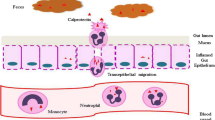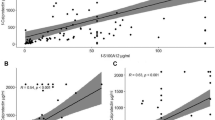Abstract
Context
The usefulness of stool calprotectin determination in diagnosis of inflammatory disease of the colon has been reported; information about its usefulness for patients with polyposis are scarce, however.
Objective
To evaluate the significance of stool calprotectin concentrations for patients affected by colonic polyposis.
Patients
Sixty-three consecutive patients (35 males, 28 females, mean age 60.3 years, range 39–78 years) were enrolled: 26 patients (41.3%) with polyps, 17 patients (27.0%) with asymptomatic diverticular disease, and 20 subjects (31.7%) with normal endoscopic appearance of the colon.
Results
Stool calprotectin concentrations were 17.4 ± 24.5 μg g−1 for patients with colonic polyposis, significantly higher than concentrations for patients with diverticulosis (7.1 ± 5.7 μg g−1; P = 0.026) or for patients with normal appearance of the colon (calprotectin 6.0 ± 5.8 μg g−1; P = 0.003). For patients with a single polyp, stool calprotectin concentrations were similar to those for patients with multiple polyps. Calprotectin fecal concentrations for patients with sessile polyps and those with flat polyps were not significantly different. Calprotectin concentrations were not significantly related to the size of the polyps.
Conclusion
Our data show that colonic polyposis may cause an increase in stool calprotectin values and that these colonic lesions should be suspected when elevated stool calprotectin concentrations are found.

Similar content being viewed by others
References
Johns LE, Houlston RS (2001) A systematic review and meta-analysis of familial colorectal cancer risk. Am J Gastroenterol 96:2992–3003
Jorgensen OD, Kronborg O, Fenger C (1993) The funen adenoma follow-up study. Incidence and death from colorectal carcinoma in an adenoma surveillance program. Scan J Gastroenterol 28:869–874
Rex DK, Johnson DA, Lieberman DA (2000) Colorectal cancer prevention: screening recommendations of the American College of Gastroenterology. Am J Gastroenterol 95:868–877
O’Hare A, Fenlon H (2006) Virtual colonoscopy in the detection of colonic polyps and neoplasms. Best Pract Res Clin Gastroenterol 20:79–92
Ahmed FE (2003) Colon cancer: prevalence, screening, gene expression and mutation, and risk factors and assessment. J Environ Sci Health C Environ Carcinog Ecotoxicol Rev 21:65–131
Gutfeld O, Prus D, Ackerman Z, Dishon S, Linke RP, Levin M, Urieli-Shoval S (2006) Expression of serum amyloid A, in normal, dysplastic, and neoplastic human colonic mucosa: implication for a role in colonic tumorigenesis. J Histochem Cytochem 54:63–73
Voganatsi A, Panyutich A, Miyasaki KT, Murthy RK (2001) Mechanism of extracellular release of human neutrophil calprotectin complex. J Leukoc Biol 70:130–134
Roseth AG, Fagerhol MK, Aadland E, Schjonsby H (1992) Assessment of the neutrophil dominating protein calprotectin in feces. A methodologic study. Scand J Gastroenterol 27:793–798
D’Inca R, Dal Pont E, Di Leo V, Ferronato A, Fries W, Vettorato MG, Martines D, Sturniolo GC (2006) Calprotectin and lactoferrin in the assessment of intestinal inflammation and organic disease. Int J Colorectal Dis epub ahead of print
Orlando A, Modesto I, Castiglione F, Scala L, Scimeca D, Rispo A, Teresi S, Mocciaro F, Criscuoli V, Marrone C, Platania P, De Falco T, Maisano S, Nicoli N, Cottone M (2006) The role of calprotectin in predicting endoscopic post-surgical recurrence in asymptomatic Crohn’s disease: a comparison with ultrasound. Eur Rev Med Pharmacol Sci 10:17–22
Vermeire S, Van Assche G, Rutgeerts P (2006) Laboratory markers in IBD: useful, magic, or unnecessary toys? Gut 55:426–431
Bremner A, Roked S, Robinson R, Phillips I, Beattie M (2005) Faecal calprotectin in children with chronic gastrointestinal symptoms. Acta Paediatr 94:1855–1858
Vieten D, Cairns P (2005) The role of calprotectin in the diagnosis of neonatal necrotising enterocolitis. Ir Med J 98:69
Roseth AG (2003) Determination of faecal calprotectin, a novel marker of organic gastrointestinal disorders. Dig Liver Dis 35:607–609
Tibble JA, Sigthorsson G, Foster R, Scott D, Fagerhol MK, Roseth A, Bjarnason I (1999) High prevalence of NSAID enteropathy as shown by a simple faecal test. Gut 45:362–6
Homann C, Christensen E, Schlichting P, Philipsen EK, Graudal NA, Garred P (2003) Ascites fluid and plasma calprotectin concentrations in liver disease. Scand J Gastroenterol 38:415–420
Ton H, Brandsnes, Dale S, Holtlund J, Skuibina E, Schjonsby H, Johne B (2000) Improved assay for fecal calprotectin. Clin Chim Acta 292:41–54
Saverymuttu SH, Maltby P, Batman P, Joseph AE, Maxwell D (1986) False positive localisation of indium-111 granulocytes in colonic carcinoma. Br J Radiol 59:773–777
Tibble J, Sigthorsson G, Foster R, Sherwood R, Fagerhol M, Bjarnason I (2001) Faecal calprotectin and faecal occult blood tests in the diagnosis of colorectal carcinoma and adenoma. Gut 49:402–408
Hoff G, Grotmol T, Thiis-Evensen E, Bretthauer M, Gondal G, Vatn MH (2004) Testing for faecal calprotectin (PhiCal) in the Norwegian Colorectal Cancer Prevention trial on flexible sigmoidoscopy screening: comparison with an immunochemical test for occult blood (FlexSure OBT). Gut 53:1329–1331
Kang JY, Dhar A, Pollok R, Leicester RJ, Benson MJ, Kumar D, Melville D, Neild PJ, Tibbs CJ, Maxwell JD (2004) Diverticular disease of the colon: ethnic differences in frequency. Aliment Pharmacol Ther 19:765–769
Souques M, Lassalle M, Guldner L, Asselain B, Barres D, Pavis C, Dubois G, Martin E, Flejou JF (2006) Colorectal polyps and cancers diagnosed by pathologists in Ile de France Region Crisapif-Petri Study. Gastroenterol Clin Biol 30:587–593
Dobbins C, Defontgalland D, Duthie G, Wattchow DA (2006) The relationship of obesity to the complications of diverticular disease. Colorectal Dis 8:37–40
Betes M, Munoz-Navas MA, Duque JM, Angos R, Macias E, Subtil JC, Herraiz M, De La Riva S, Delgado-Rodriguez M, Martinez-Gonzalez MA (2003) Use of colonoscopy as a primary screening test for colorectal cancer in average risk people. Am J Gastroenterol 98:2648–2654
Author information
Authors and Affiliations
Corresponding author
Rights and permissions
About this article
Cite this article
Pezzilli, R., Barassi, A., Morselli Labate, A.M. et al. Fecal Calprotectin Levels in Patients with Colonic Polyposis. Dig Dis Sci 53, 47–51 (2008). https://doi.org/10.1007/s10620-007-9820-6
Received:
Accepted:
Published:
Issue Date:
DOI: https://doi.org/10.1007/s10620-007-9820-6




